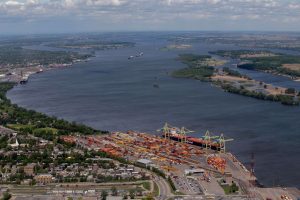Canadian Great Lakes-Seaway shipping improved in May, strengthened by agricultural-related exports to Europe, steel imports and shipments of oversized project cargo like wind turbines for regional energy projects.
“The Great Lakes-St. Lawrence Seaway has served as a reliable and cost-effective international trade conduit for North American farmers and manufacturers this spring amidst continuing global chaos in other supply chains,” said Terence Bowles, President and CEO of The St. Lawrence Seaway Management Corporation. “At the same time, some of our key domestic cargos such as refined liquid bulk that support Canadian air travel and ground transportation are bouncing back after pandemic-related decreases during the past two years.”
Overall cargo tonnage shipments (from March 22 to May 31) via the St. Lawrence Seaway totaled 7.6 million metric tons, down 10.8% compared to 2021 but gaining ground in comparison to April, following a slow start to the season due to ice conditions in Lake Superior.
Highlights include a 400% jump in Prairie potash exports, a key ingredient used in fertilizer, and a 20% increase in domestic road salt shipments to replenish municipal reserves.
The shipping season is also being buoyed by a 32% rise in refined products such as jet fuel, diesel and gasoline, being transported through the St. Lawrence Seaway on domestic tankers to serve improved demand for air travel and ground transportation in Ontario and Quebec. However, demand for gas and diesel at the pumps has not recovered completely to pre-COVID levels due to high prices and continuing work-from home trends. As a result, finished petroleum products are also being shipped to Quebec for export overseas.
Although Canadian grain shipments through the Seaway are down 25% this season, that is due to lower Prairie volumes following last year’s weather-beaten harvest. Southern Ontario ports are reporting strong shipments of local corn and soya to European markets.
Port Windsor is seeing strong increases in foreign ship activity with year-to-date steel shipments up 70%, cement up 89%, corn up 130% and soya meal up 427%. Corn and soya exports were destined for England and Ireland.
Salt, which is carried on domestic ships to North American markets, is running even with 2021 and aggregates are catching up after a late spring thaw at the northern quarries. The port has seen a strong return of Great Lakes cruise ships, with a Viking vessel making its first docking, and another dozen visits expected this summer by various cruise operations.
The Port of Hamilton has also seen an acceleration in grain exports, especially corn and soybeans. “As we head into summer, we’ve already seen more than 800,000 metric tonnes of grain exports through the Port of Hamilton, 42% higher than the same time last year,” said Ian Hamilton, President & CEO, HOPA Ports. “Ontario grain makes an important contribution to food security globally. The Port of Hamilton is the largest export gateway for Ontario-grown grain, and we’re pleased to see crops moving from field, to vessel, to ports around the world as part of a resilient and efficient supply chain.”
At the Port of Thunder Bay, shipments of Western Canadian potash have quadrupled compared to the same period last year. Terminals in Thunder Bay have loaded out 280,000 metric tons of potash in less than two months; this is half of the port’s yearly average. Canada is the world’s largest exporter of potash. Thunder Bay, the only export port on the Seaway for potash, handles shipments moving to Europe, North Africa, and South America.
Inbound shipments of general cargo at Keefer Terminal are also strong. General cargo shipments were strong through the first two months of the season. Keefer Terminal handled over ten thousand metric tons of steel pipe and rail, in addition to a shipment of wind turbine tower sections from Europe. Keefer’s large laydown area is a unique port asset that helps attract western-bound general cargo to the Seaway-Thunder Bay route. (Photo Port of Thunder Bay)








